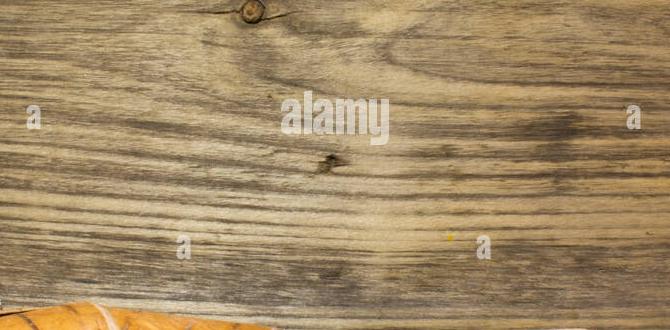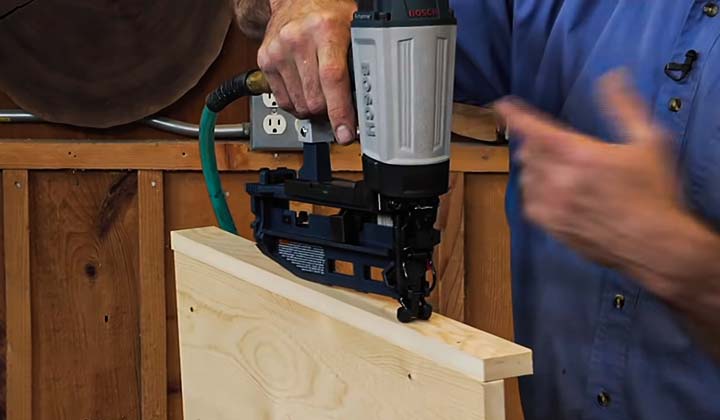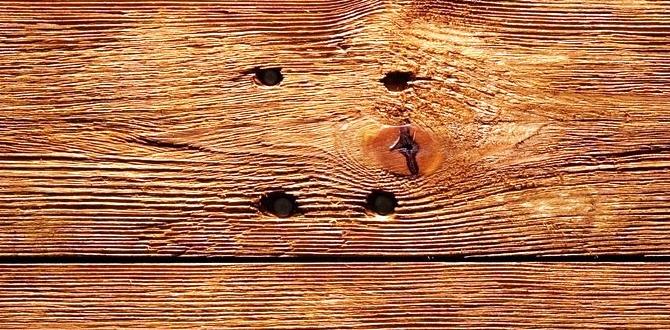Have you ever wondered about the best tools for your DIY projects? When it comes to nailing, the finish nailer and pin nailer are two popular options. Each tool shines in different scenarios and understanding their uses can save you time and effort.
Imagine working on a beautiful picture frame. A finish nailer can fasten the joints quickly. But, what if you need a lighter touch? That’s where a pin nailer comes in handy. It leaves smaller holes, making it ideal for delicate crafts.
Fun fact: Did you know that the finish nailer can drive nails up to 2.5 inches long? This makes it perfect for thicker wood. On the other hand, pin nailers work with tiny pins less than 2 inches. They are great for trim and smaller projects.
Let’s dive into their use case comparison! You’ll learn which tool fits your needs best. Whether you’re a beginner or a seasoned pro, knowing how to choose can make all the difference.
Table of Contents
Finish Nailer Vs Pin Nailer Use Case Comparison: Which To Choose?
Choosing between a finish nailer and a pin nailer can be tricky. Each tool serves its own purpose. A finish nailer drives larger nails for strong joinery. It’s great for tasks like molding and heavy furniture assembly. On the other hand, a pin nailer uses tiny pins. This tool is perfect for delicate work, like attaching thin trim without leaving visible holes. Imagine crafting a beautiful picture frame. Wouldn’t you want a nailer that keeps it neat? Understanding these differences helps you pick the right tool for your next project.
Understanding Finish Nailers
Definition and mechanics of finish nailers. Common applications and projects for finish nailers.
A finish nailer is a handy tool that shoots thin nails to secure wood pieces together. It works like a mini cannon, using air pressure to drive nails deep into the material. This tool is perfect for projects like installing crown molding, baseboards, or furniture assembly. Imagine building a treehouse, and making sure those boards stay together without popping out! Finish nailers are the superheroes of woodworking, ensuring everything looks neat and tidy.
| Common Applications | Description |
|---|---|
| Trim Work | Great for securing moldings and trims. |
| Cabinetry | Perfect for assembling cabinets that need to look sharp. |
| Furniture Repair | Helps fix and build furniture with a smooth finish. |
Understanding Pin Nailers
Definition and mechanics of pin nailers. Typical uses and benefits of pin nailers.
A pin nailer is a tool that drives small pins into wood. It uses compressed air to shoot these tiny fasteners quickly. Pin nailers are perfect for delicate projects because they leave small holes. They are great for tasks like attaching thin trim or molding. With pin nailers, you get strong hold without damaging the material. Here are some common uses:
- Fixing delicate pieces of wood
- Attaching small trim or molding
- Crafting projects like models
Using a pin nailer makes your work clean and easy. It’s a favorite among builders and hobbyists alike!
What are the benefits of using a pin nailer?
Pin nailers are precise, quick, and leave less damage compared to larger nails. They also help in avoiding splits in thin wood, making your projects look professional.
Key Differences Between Finish Nailers and Pin Nailers
Nail size and type compatibility. Driving power and holding strength comparisons.
Finish nailers and pin nailers serve different purposes, and knowing their key differences can save you from a DIY disaster. First, let’s talk about nail size. Finish nailers use larger nails, typically 1.25 to 2.5 inches long. These nails hold heavy furniture together like a bodybuilder in a hug! In contrast, pin nailers use tiny nails that are usually 1 to 1.5 inches long—perfect for delicate work, but they might not hold like a bouncer at a nightclub.
| Nailer Type | Nail Size | Driving Power | Holding Strength |
|---|---|---|---|
| Finish Nailer | 1.25 to 2.5 inches | Higher | Strong |
| Pin Nailer | 1 to 1.5 inches | Lower | Light |
So, if you need strength, reach for the finish nailer. For lighter tasks, the pin nailer is your buddy. Remember, using the wrong tool can turn your project into a comedy show—nobody wants that!
Best Use Cases for Finish Nailers
Ideal projects for finish nailers: trim, molding, cabinetry. Advantages of using finish nailers in specific applications.
Finish nailers are great for several projects. They work best on trim, molding, and cabinetry. These tools help attach small pieces of wood easily. They leave a clean finish and hold strong. Using a finish nailer saves time and energy when you work on your home. Here are some benefits:
- Quick installation without damaging the wood.
- Provides a smooth appearance with minimal holes.
- Ideal for detailed work, making things look professional.
What projects are best for finish nailers?
Finish nailers work best for detail jobs like trim, molding, and cabinetry. They provide clean, professional results. You can even do small DIY projects for your home.
Best Use Cases for Pin Nailers
Ideal projects for pin nailers: delicate trim, craftwork, furniture. Benefits of using pin nailers in detailed work.
Pin nailers are great for many special projects. They work well with delicate trim, where you want to avoid damage. These tools are also perfect for craftwork, like making models or decorations. When building furniture, they help hold pieces together without leaving big holes. The small nails create a clean finish. It’s easy to hide them, making your work look professional.
What are the benefits of using pin nailers?
Pin nailers are precise and fast. They help you do detailed work with less damage. Less force means fewer chances to crack or split wood. Their small nails are less visible, giving a neat look to your projects.
- Perfect for small wood pieces
- Great for thin materials
- Minimizes damage to surfaces
The Importance of Nail Size and Type in Use Cases
Effects of nail length and gauge on project outcomes. How to choose the right nailer based on material and application.
Nail size and type play a big role in your DIY projects. The right nail can change everything! Longer nails hold better, while shorter ones are great for delicate work. A gauge refers to the thickness of the nail, where smaller numbers mean thicker nails. For thicker materials, use a heavier gauge; for thinner ones, stick with lighter nails. This choice affects how strong and neat your project will be.
| Nail Type | Best for |
|---|---|
| Finish Nailer | Wood projects and trim work |
| Pin Nailer | Thin materials and fine detail work |
Choosing the right nailer depends on your material and application. For heavy work, go for a finish nailer. If you need finesse, a pin nailer will do the trick. Remember, the right nail can save you from looking like you used spaghetti for your project! So, pick wisely and nail it!
Cost and Investment Considerations
Pricing comparison between finish nailers and pin nailers. Longterm value and durability analysis.
Choosing between a finish nailer and a pin nailer involves costs that matter. Finish nailers generally cost more. They range from $100 to $300. Pin nailers cost less, usually between $50 and $150. Long-term value shows that finish nailers work well for heavy tasks. A finish nailer can last years with proper care. Pin nailers are good for small jobs but might need replacing sooner. So, consider what you will use it for before buying.
What should I consider when deciding on pricing?
Think about your needs. Finish nailers cost more but offer durability. Pin nailers are budget-friendly, fitting for smaller tasks.
Key Cost Aspects
- Finish nailers: $100 – $300
- Pin nailers: $50 – $150
- Long-term use favors finish nailers
Conclusion
In summary, finish nailers are best for heavy-duty projects, while pin nailers work well for delicate tasks. You’ll find finish nailers great for securing large pieces, while pin nailers are perfect for trim and small details. Choose the right tool based on your project needs. For more tips, check out guides on woodworking tools or ask an expert!
FAQs
What Are The Primary Applications For A Finish Nailer In Woodworking Projects Compared To Those Of A Pin Nailer?
A finish nailer is great for bigger projects, like building furniture or putting on trim. It uses larger nails, which hold things together better. A pin nailer is perfect for small jobs, like attaching delicate pieces without leaving marks. You can use it for things like picture frames or small crafts. So, use a finish nailer for strength and a pin nailer for precision.
How Do The Fastening Capabilities Of A Finish Nailer Differ From Those Of A Pin Nailer In Terms Of Nail Size And Holding Power?
A finish nailer uses bigger nails than a pin nailer. These bigger nails hold things together better. You can use a finish nailer for heavier items. A pin nailer is for small, light projects like trims. So, finish nailers are stronger, while pin nailers are for delicate jobs.
In What Scenarios Would A Woodworker Prefer To Use A Pin Nailer Over A Finish Nailer For Assembly Or Finish Work?
You might choose a pin nailer when you want to attach very small or thin pieces of wood. It makes tiny holes that are easy to hide. This is great for delicate projects, like making small models or detailed crafts. A pin nailer also works well when you don’t want to split the wood.
What Factors Should Be Considered When Choosing Between A Finish Nailer And A Pin Nailer For Trim Work In Home Improvement Projects?
When choosing a finish nailer or a pin nailer, think about the job. A finish nailer uses bigger nails. It works well for heavy pieces like baseboards. A pin nailer uses tiny nails, making it good for small items like thin trim. Choose the tool that fits what you are building!
How Do The Aesthetics Of A Project Differ When Using A Finish Nailer Versus A Pin Nailer, Especially Regarding Visible Nail Heads And Potential For Wood Splitting?
When you use a finish nailer, you get bigger nail heads that might show on the surface. This can change how your project looks. A pin nailer uses tiny nails with small heads that are harder to see. Plus, pin nailers are less likely to split the wood, making your work look smoother.







